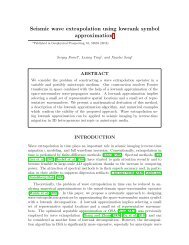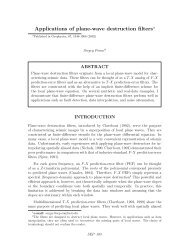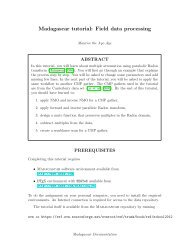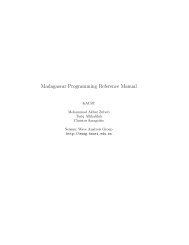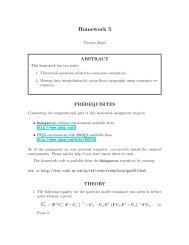Using IWAVE - Madagascar
Using IWAVE - Madagascar
Using IWAVE - Madagascar
You also want an ePaper? Increase the reach of your titles
YUMPU automatically turns print PDFs into web optimized ePapers that Google loves.
8<br />
DISCUSSION AND CONCLUSION<br />
The rather large and only slowly disappearing error revealed by the examples from<br />
Symes and Vdovina (2009) suggests strong limits for the accuracy of regular grid<br />
finite difference methods. Finite element methods suffer from the same limitations:<br />
accurate solution of acoustodynamic or elastodynamic problems appears to demand<br />
interface-fitted meshed (Cohen, 2002), with the attendant increase in code and computational<br />
complexity.<br />
The situation may not be so bleak, however. For one special case, namely constant<br />
density acoustics, Terentyev and Symes (2009) show that a regular grid finite<br />
difference method, derived from a regular grid Galerkin finite element method, has<br />
accuracy properties one would expect in homogeneous media (second order convergence,<br />
reduction of grid dispersion through higher order space differencing) even for<br />
discontinuous models: the interface error effect is attenuated. This type of result<br />
actually goes quite far back in computational geophysics (see for example Muir et al.<br />
(1992)), though theoretical support has been slower in coming.<br />
Pure regular grid methods cannot take advantage of changes in average velocity<br />
across the model, and concommitant changes in wavelength. Coupling of local<br />
regular grids is possible, however, and can yield substantial computational efficiency<br />
through grid coarsening in higher velocity zones - see Moczo et al. (2006). <strong>IWAVE</strong><br />
already accommodates multiple grids (in domain decomposition parallelism), and<br />
extension to incommensurable multiple grids would be a significant change, but in<br />
principle straightforward. The use of logically rectangular but geometrically irregular<br />
(“stretched”) grids is completely straightforward, on the other hand.<br />
These and other extensions, both past and future, are eased by the reusability<br />
designed into the <strong>IWAVE</strong> core framework. This design has produced reasonably wellperforming<br />
and easy-to-use applications, and has proven extensible to new models<br />
and schemes. Moreover, as explained by Symes et al. (2011), the object-oriented<br />
design of <strong>IWAVE</strong> dovetails with similarly designed optimization software to support<br />
the construction of waveform inversion software. The inversion applications resulting<br />
from this marriage inherit the features of <strong>IWAVE</strong> - parallel execution, high-order<br />
stencils, efficient boundary conditions, simple job control - without requiring that<br />
these aspects be reworked in the code extensions.<br />
The <strong>IWAVE</strong> acoustic application supports many use cases beyond those of the<br />
scripted examples, such as various modes of parallel execution, array sources, movie<br />
output, 3D modeling, and many others described in the documentation. It is hoped<br />
that the brief overview above, the detailed description of the example parameters<br />
given in Appendix A, and the much more extensive description of use cases in (Terentyev<br />
et al., 2012) will enable the reader to constuct a wide variety of synthetic data<br />
sets with relative ease.




